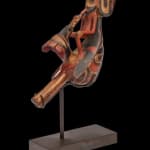A pigmented wood Tsimshian Chief’s ceremonial ‘Raven’ rattle
This finely detailed rattle, crafted from
pigmented wood in red and black, was made by the Tsimshian, an indigenous group
of people with roots in the north-western region of British Columbia, Canada.
It was a matrilineal society, in which children would inherit their lineage or
clan affiliation from their mothers. There were four lineages: Raven, Wolf,
Eagle, and Fireweed. Their society was divided in three main classes: nobles,
commoners, and slaves. The nobility included the immediate family of the chief.
Raven rattles are a unique kind of
ceremonial instrument, shaken rhythmically to accompany ritual performances of
chiefs. The composition exists of a raven with a human figure on his back.
Incorporated in the raven’s tail is another bird’s head which holds a frog in
his beak. The tongue of the frog makes contact with the human figure. This
union forms the bridge through which the magic force flows. The belly of the
raven has the structure of a face. The use of black and red decoration and rows
of dashing are typical of the mid nineteenth century.
The raven, a central figure in Tsimshian
mythology, holds a position of great importance. It is believed to bring light
and life into the world, symbolized by the small ball held in the mouth of the
raven. It is believed to be a bridge between the human and spiritual world.
Power in Tsimshian society was derived from encounters between the ancestors
and spiritual beings that controlled all resources. It has been suggested that
the raven/human imagery of these rattles illustrates Raven the Creator's own self-creation.
Nass-shaki-yeil (Raven-at-the-head-of-the-Nass) was the keeper of all the light
in the world and was often depicted as a huge bird with a completely recurved
beak. Raven entered the body of the daughter of Nass-shaki-yeil by disguising
himself as a hemlock needle in her drinking water and was reborn as her
raven/human child. The raven child later stole the light from his grandfather
and released it to the world. Nass-shaki-yeil is a high-ranking crest of the
Gaanax.ádi Tlingit (as well as certain Tsimshian-speaking groups), and it may
be that this important mythological figure is represented by the formline face
with a recurved beak seen on the back of nearly all raven rattles.
A similar rattle can be found in the
collection of The Metropolitan Museum of Art, New York, on permanent view in
Gallery
89.4.2161)
Source:
Steven C. Brown. Native Visions: Evolution
in Northwest Coast Art from the Eighteenth through the Twentieth Century,
University of Washington Press, 199881.
Provenance
Provenance:Private collection, BrusselsCollection Lemaire, Amsterdam (c. 1990)
Collection Pelt, the Netherlands



